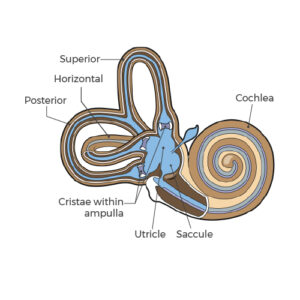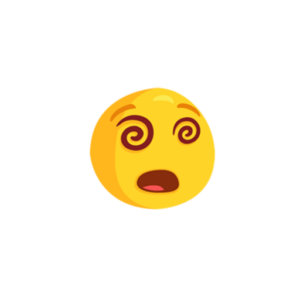What Causes Dizziness?
Understanding Vertigo (dizziness) and Treatment Options
Vertigo or dizziness is often described as feeling off-balance or as if the room is spinning (when it’s not). Oftentimes, simple movements can feel very intense and impact your everyday life. Having your daily routine impacted or halted due to severe vertigo can be very distressing.
Vertigo isn’t a disease on its own. It’s a symptom of other conditions. Determining the cause of your dizziness to develop an individualized treatment plan to address the root cause is where your health provider will begin.
Types of Vertigo and Their Root Causes

Anatomical View of the Semi-circular Canals
BPPV (Benign Paroxysmal Positional Vertigo) is the most common and prevalent cause of dizziness or vertigo. It occurs when small calcium particles are dislodged from one of three canals of the inner ear and disrupt the signals to the brain. Depending on which canal is affected, different head and body positions will yield symptoms. Most commonly, symptoms occur:
- while bending forward and rolling over in bed.
- Symptoms are typically severe and short-lived but can make it extremely difficult to sleep at night and put your shoes on in the morning.
Post-Concussion – Concussions occur with forced trauma to the head or whiplash-like injuries causing mild injury to the brain. Common with contact sports, especially football and wrestling, post-concussion vertigo can occur in a variety of ways and last anywhere from a week to 2 or 3 months. Typical signs and symptoms include:
- short term memory loss
- balance deficits
- dizziness
- possible loss of consciousness.
Symptoms lasting longer than 3 months is a condition referred to as post-concussive syndrome. Common symptoms include:
- headaches
- dizziness
- neck pain
- fatigue
- irritability.
Research indicates there are a variety of factors that cause post-concussive syndrome including physical injury to the brain, communication disruption within the nervous system, and emotional factors including coping mechanisms and stress management.
Meniere’s – Meniere’s is a chronic cause of dizziness that is typically caused by an abnormal amount of fluid in the inner ear. It is largely unknown how this fluid accumulation occurs, but research indicates it may be caused by autoimmune diseases, allergies, and genetics. Unlike other forms of vertigo, Meniere’s can cause recurring dizziness lasting hours at a time unrelated to a change of position that starts and ends spontaneously without reason. Other symptoms include:
- hearing loss,
- ringing in the ear, and
- fullness of the ear.
In conjunction with physical therapy, consultation with a medical specialist would be warranted.
Cervicogenic – Although not an official diagnosis of dizziness, the cervical spine has a major impact on the system that regulates our balance. – Many times, neck pain and dizziness coexist. People with dizziness involving a cervicogenic component report symptoms of dizziness, typically with head movement, that is accompanied by neck pain. They will also report a decrease or increase in dizziness as neck symptoms get better or worse.

Assessment of Symptoms for Dizziness.
How is Vertigo Diagnosed?
When meeting with your medical provider to assess symptoms of dizziness or vertigo, it is very important to be thorough and specific during the question-and-answer portion of the examination. The answers you provide can often be the determining factors in producing a diagnosis. Your provider will also perform a series of non-invasive tests to help determine the origin of the symptoms. The most common methods for testing for vertigo include:
Dix Hallpike Maneuver –When it comes to the most common type of vertigo, BPPV (Benign Paroxysmal Positional Vertigo) the Dix Hallpike maneuver is the first and most utilized assessment. It includes a variety of movements including lying on your back, on your side, and sitting upright while also performing different head movements. It is important to consult a medical professional familiar with vertigo BEFORE attempting this maneuver as it can make it dramatically worse if done incorrectly.
During the assessment, it is common for symptoms to be reproduced and it is important to report when those symptoms begin to dissipate. Determining which ear canal is affected is important to guide future treatment techniques.
Balance Test – There are three components to the balance system:
- vision
- vestibular – the sensory system that is responsible for providing our brain with information about motion, head position, and spatial orientation.
- somatosensory -our ability to feel or sense pressure from the ground underneath us.
When one of these systems is compromised, balance can be severely affected and you can become dizzy. Testing each system is important to determine the role each one plays in balance deficits.
Assessment of Eye Movements – There is a vision condition called nystagmus in which the eyes make repetitive, uncontrolled movements that often result in reduced vision and depth perception. They can also affect balance and coordination. Based on the findings during the examination, this will guide treatment of the deficits found.
Treatments for Dizziness.
Help is available.

Dealing with severe vertigo can interrupt daily routines, but there are many treatments that can help. After a proper assessment and identification of the root cause of your vertigo symptoms, a physical therapist can create an individualized treatment plan. This plan will address your condition and avoid extending your symptoms for a longer period. To give you an idea of what to expect, here are three types of treatments that are frequently used for vertigo sufferers.
Epley Repositioning Maneuver – As mentioned earlier, BPPV is the most common type of vertigo. The Epley maneuver is usually the first treatment therapists use for their patients. Through specific movements of the head, the Epley maneuver can offer relief by repositioning the dislodged calcium crystals causing dizziness or nausea. It is important to consult a medical professional familiar with vertigo BEFORE attempting this maneuver as it can make it dramatically worse if done incorrectly.
Vestibular Therapy – Vestibular therapy addresses both the primary cause of vertigo as well as any secondary impairments such as poor balance, unsteadiness in walking, neck pain, and general deconditioning. Therapy regimens include graded exercises including balance activity, postural strengthening and retraining, eye/head movements while walking, and aerobic exercise. It should be noted during these activities it is completely normal to experience symptoms. Your physical therapist will discuss a threshold at the beginning of the session to avoid severe bouts of dizziness.
Manual Therapy – When vertigo is caused due to spinal or postural issues, manual techniques will be utilized to address dizziness and nausea. These techniques will include soft tissue mobilization (massage), joint mobilization (chiropractic), and passive movement to reduce tissue tension and improve mobility of the cervical spine.
Acupuncture – A long-standing treatment of dizziness, vertigo, and nausea is the use of specific acupuncture and acupressure point to ease the symptoms of vertigo and dizziness.
Despite how common vertigo is, many people are unaware of how much physical therapy can help. It is one of the most effective options for managing and treating vertigo. If you are suffering with dizziness and/or nausea, it could be the result of a form of vertigo. Making an appointment with a provider to assess and create a treatment plan can make all the difference and help you regain the normalcy that vertigo so abruptly disrupts.


